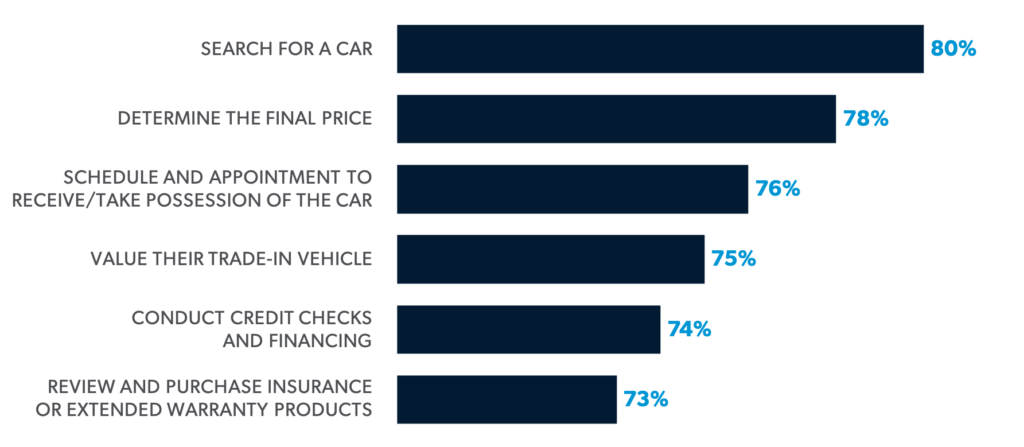Beyond the Technology: How Digital F&I Teams Can Achieve Sustainable Growth
As the pandemic eases its grip, the auto industry faces shortages. This will ease too, but online car shopping is growing and consumers want a better buying experience… including improved F&I interactions. The industry has definitely entered a new digital-first environment.
Research shows that 70% of car buyers want to conduct more of the buying cycle online than they used to. Some see it as a way to avoid the frustrating parts of car buying, such as pouring over paperwork, while others prefer the speed and convenience of online processes.
Research bears this out. A recent Google study (albeit completed before the pandemic) found that 92% of car buyers perform research online before they buy. And while most Americans still want to finalize a car purchase in a dealership, the Deloitte 2021 Global Automotive Consumer Study reveals that only 54% of consumers aged 18 to 35 still want in-person transactions.
A September 2020 Harris Poll of 2,000+ recent car buyers revealed exactly what parts of the process they’d most like to do online instead of in-person:

In turn, the technology to facilitate digital/remote sales and F&I processes has developed rapidly. All the major menu and CRM providers can support those sales. Independent software vendors offer an array of technology solutions to help you meet the buyer where they are, and how they want to interact. The virtually empowered customer wants it, the technology is there that can meet their expectations—so what is holding F&I departments back from taking advantage of this trend?
There is no doubt that COVID-19 and the resulting stay-at-home orders and restrictions accelerated the pace of change, pushing all of us further down the road to a more digitally inclusive sales process. However, feedback from auto dealers and dealership managers ranges from a desire to fully embrace remote, digital sales and F&I processes that allow the customer to define their purchase experience, to dealers that refuse to even discuss it.
It’s a Seller-Driven Market (For Now)
Now that we are all coming out of our hiding places and getting back to business, a microchip shortage has forced manufacturers to curtail new vehicle production. Consulting firm AlixPartners estimates that during 2021 the chip shortage will cost the global auto industry $110 billion in revenue. Demand is up, production is down and inventories are shrinking. The reduced supply is not limited to just new vehicles. Used vehicles are scarce and wholesale prices are up 54% from a year ago. Rental companies like Hertz, Avis and Enterprise, typically suppliers of used vehicle inventory, are competing with dealers for the cleanest used vehicles at auctions, to supply the now growing rental car need.
With low supply, and increasingly high-demand sellers in control once again, the question is, how long with this last? In a seller-driven marketplace the urgency to adopt buyer-centric sales practices can be stalled while sales teams focus on the immediate selling situation. But as my mother used to say, “this too shall pass”.
Faster than we know it, the supply chain will fill up, the demand will flatten and we will be competing based on customer experience once again. Cox Automotive economist Jonathan Smoke predicts that by the end of June, wholesale prices will stabilize and 6 to 8 weeks later the retail market will follow suit. Gross margins are fine for now but they may not stay that way. The chip shortage may end by September 2021, according to some projections; and the supply of used cars is expected to rise by July.
Get Ready for What’s Next or Risk Market Share
When the market shifts, it will be the dealerships whose teams are most focused on the customer experience that will stand out. In the long run, simply having the car a customer wants is not good enough. Helping a consumer complete the buying journey, one that allows them to learn about the car, complete the sales transaction, and enjoy an after-sales experience that proves you value the customer throughout the ownership cycle, will separate you from everyone else.
It’s incumbent upon owners and operators to focus as much on the strategic as the immediate. The opposite of differentiation is doing what everyone else is doing. Now is the time to determine your strategy and prepare your team for the next phase.
Meeting the consumer where they are and when they are ready will sell more cars in the long run and make more money.
Sell F&I How You Like to Buy
Meeting the buyer where they are starts with understanding who they are. But the more remote and online our sales process becomes, the easier it is to dehumanize our customer. When we talk about customers, it’s easy to create a “we versus them” mentality. What we all should remember is that we are them. We are all buyers of something or another and we are by nature and reality consumers. What the car buying public wants is not significantly different than any other customer. Ask yourself: How do you like to buy? We crave convenience and we also crave human contact. And we generally buy from those we like, trust and admire, which is based on building a genuine relationship, and that takes work.
In a world where we have all spent the last year restricted and isolated, confused and fearful, dealerships and their F&I departments that adopt customer-centric selling techniques will perform better, remain competitive and increase their long-haul revenue potential. It’s time to make that change, and to put the fun factor back into buying a car, too.
A Customer-centric F&I Mindset is a Must
Even dealerships that are ordinarily considered progressive when it comes to the vehicle sales process can be laggard in meeting customers where they are in the F&I space. That’s because for decades they’ve been trained in the old-school way. For instance, you never quote a payment over the phone or never discuss product until the buyer has been closed on a car and is physically present in the dealership.
The one key obstacle to adopting a customer-centric F&I approach is mindset. We can no longer ascribe to the adage, “control your customer.” It’s clear that customers are in control. They demand transparency, and the ability to research. That includes looking into finance options and F&I products on their own. They want dealerships to be authentic and worthy of trust, and want the ability to transact remotely.
Your F&I department needs the technological tools and the space, like they always have, but now it comes down to training your F&I department differently. They need to understand how to honestly communicate to today’s digitally active, always-on customer. They need to know how to fine-tune their selling approach to put the customer first.
You can’t plug a hole with all the new technology until you change your mindset.
How Digital F&I Teams Can Attain Sustainable Growth
Ease into that change by following these five steps, designed to help your digital F&I team achieve sustainable goals
1. Define your goals.Beyond today’s volume and gross, what is important to you? What is the experience you want to deliver? What are your customer retention goals? What about employee experience? The auto industry’s track record on employee retention has not been a source of pride, and about the only thing scarcer than used cars is people willing to come work in our business. Can a better customer experience produce a better employee experience?
2. Set expectations for your team. Once you have defined for yourself what is important and what you seek to achieve, you need to communicate that. You can give your team the most sophisticated tools and training out there, with the belief that they will succeed; but without conveying a clear understanding of expectations, you are setting yourself and your people up for failure. It is also the number one reason an employee quits.
3. Develop a strategy. Include ways to meet consumers where they are—whether in the showroom, online, or even at their home or office. Prepare your teams to be comfortable having conversations with consumers regardless of the channel or apparent stage of the buying cycle. Make sure they are ready and willing to discuss F&I on the front end and are using it to persuade the customer to buy. Let the customer lead.
Determine who on the team is responsible for specific activities and conversations. How will your team be trained in these processes and who will lead the training? How will you track and measure the results?
4. Use technology. At MarketSource we believe that there are only three ways to improve a sales organization. Help people improve their skills, develop better processes, and use technology to increase your reach or reduce repetitive tasks and non-revenue producing activity. But the more we rely on technology, the more we need to improve our people skills. We are still grappling with the “High Tech, High Touch” dilemma that John Naisbitt, author of Megatrends, defined in 1982.
5. Maintain customer-first conversations. Engage with buyers early and along the channels they prefer, whether by email, phone or social media networks. Make sure to “speak their language”. Millennials, for instance, want to understand what they are buying. They want it to match their values or purpose in some way. They are listening to what their peers are saying about you, your dealership and the car they want, and if you are not ready to give them honest feedback they will freeze up and go somewhere else.
Interested in ramping up your F&I team to a higher level of productivity? LET’S TALK >>

